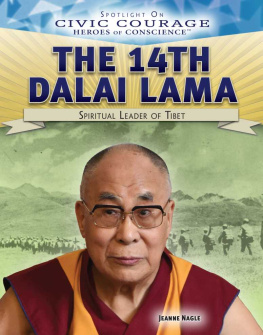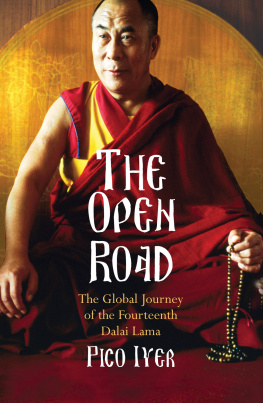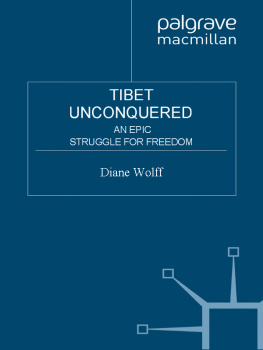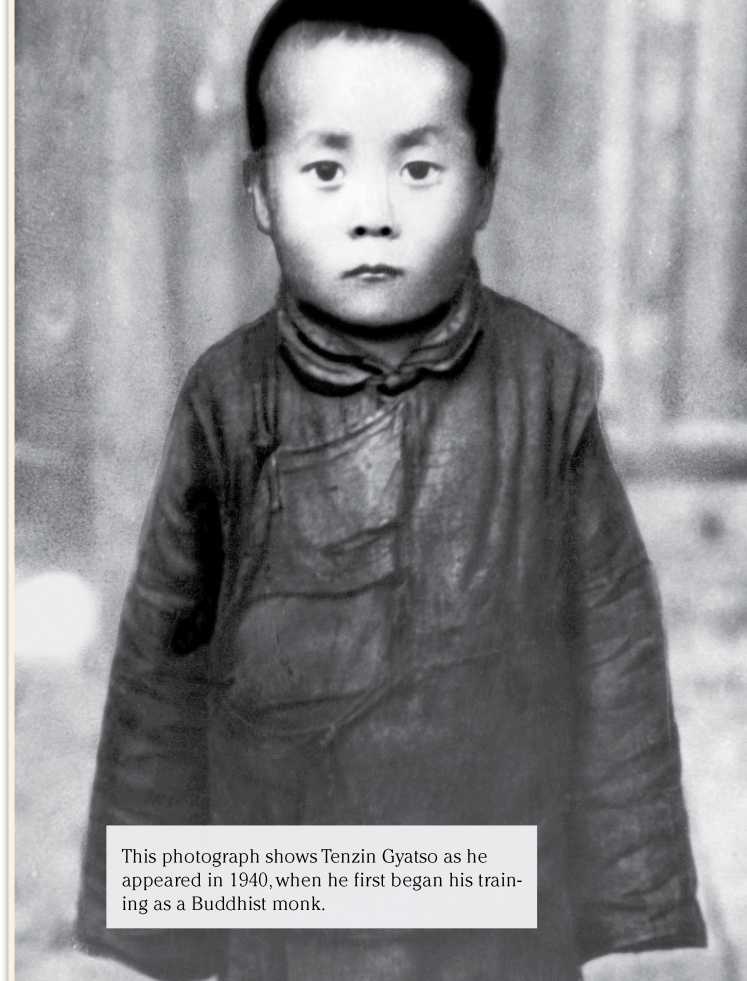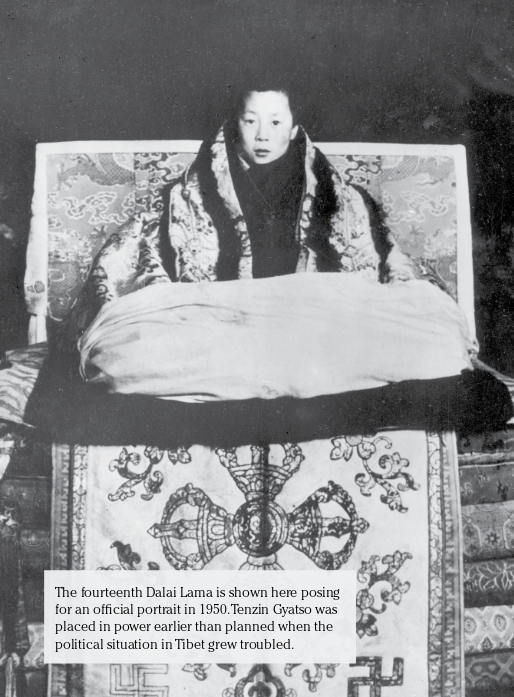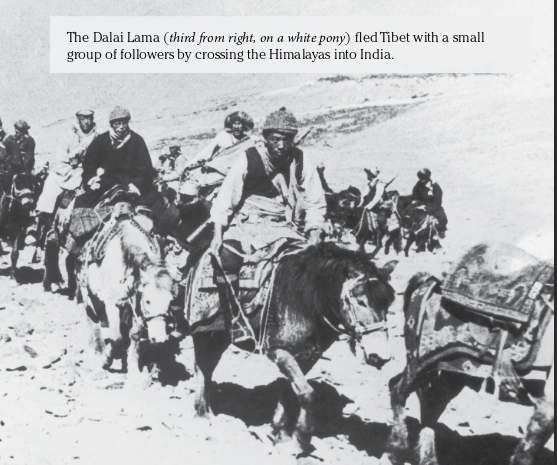Published in 2018 by The Rosen Publishing Group, Inc.
29 East 21st Street, New York, NY 10010
Copyright 2018 by The Rosen Publishing Group, Inc.
First Edition
All rights reserved. No part of this book may be reproduced in any form without permission in writing from the publisher, except by a reviewer.
Library of Congress Cataloging-in-Publication Data
Names: Nagle, Jeanne, author.
Title: The 14th Dalai Lama : spiritual leader of Tibet / Jeanne Nagle.
Description: New York : Rosen Publishing, 2018. | Series: Spotlight on civic courage: Heroes of conscience | Audience: Grades 5-10. | Includes bibliographical references and index.
Identifiers: LCCN 2017011619| ISBN 9781538380819 (library bound) | ISBN 9781538380796 (pbk.) | ISBN 9781508177456 (6 pack)
Subjects: LCSH: Bstan-zdzin-rgya-mtsho, Dalai Lama XIV, 1935Juvenile literature. | Dalai lamasBiographyJuvenile literature. | Tibet Autonomous Region (China) History-Juvenile literature.
Classification: LCC BQ7935.B777 N34 2017 | DDC 294.3/923092 [B] dc23 LC record available at https://lccn.loc.gov/2017011619
Manufactured in the United States of America
On the cover: After Chinese troops invaded Tibet (background), the fourteenth Dalai Lama, Tenzin Gyatso (foreground), faced exile and a loss of power. Through it all, he has led his people toward the promise of a free Tibet.
CONTENTS
The Situation in Tibet
T ibet is nestled high in the foothills of the Himalayas, a mountain range in Asia. It borders several countries, most notably India to the south and, to the north, China.
Once a powerful kingdom in its own right, Tibet is now the subject of tension and disputes. The Chinese government has made Tibet an autonomous region, meaning it is part of China but with limited freedoms. Tibetans, however, insist that their country should be a totally free and independent state, as it was before China seized political control in the 1950s.
If not for Chinas desire to regain control over the region, a large portion of the worlds populace might never have known that a remote, isolated place called Tibet even existed. The plight of Tibet and its peopleand their fight to become independent once moremight have faded away and been forgotten. But thanks to one leader, the Dalai Lama, it was not.
Long Live the Dalai Lama
T he title given to the religious and political leader of Tibet is Dalai Lama. Dalai is the Mongolian word for ocean," and lama is Tibetan for teacher or guru" Many people take this to mean that the Dalai Lama possesses an ocean of wisdom.
The political element of this position is important, but the spiritual connection goes back farther in history. For centuries, the Dalai Lama has been the head of the main branch of Tibetan Buddhism. It is known as the Yellow Hat sect, or religious order. His followers also believe that he is the god of compassion in human form.
In addition to being a god on Earth, the Dalai Lama is thought to be a very old soul. Buddhists believe in reincarnation, which is when a persons soul comes back to Earth in a different body or form. Starting from the late fourteenth century, there have been fourteen incarnations, or versions, of the Dalai Lama.
And a Child Shall Lead Them
T he story of the fourteenth Dalai Lama began on July 6, 1935, with the birth of Lhamo Thondup. He was born in the village of Taktser, which is located in the northeastern part of Tibet. His parents, who were farmers, had six other children as well.
Led by a number of signs, a group of Buddhist monks came to the familys farm in the village of Amdo, looking for the reincarnated Dalai Lama. Their attention turned to two-year-old Lhamo Thondup. The child was given a number of tests, which he passed. The monks were convinced that he was the reincarnation of the Dalai Lama.
From there, the monks took Lhamo Thondup first to a nearby monastery, then to the Tibetan capital, Lhasa, for training as a Buddhist monk. In 1940, he was given the holy name Tenzin Gyatso. He was only five years old.
Tenzin Gyatso continued to receive Buddhist philosophy lessons for several years, in preparation for becoming a monk. He was set to assume political leadership of Tibet once he reached the age of twenty, but that timeline was moved up when Chinese troops invaded the country in 1950.
Tenzin was quickly made the head of his countrys government in an attempt to keep as much power as possible in Tibetan hands. Even though he was not yet a monk, he was proclaimed the fourteenth Dalai Lama. He was only fifteen, so a regent was given power to rule temporarily until he was old enough to govern on his own.
The Dalai Lama asked the United Nations for help with China, but nothing much was done. Left unchecked, China wrote, and made Tibet sign, the Seventeen-Point Agreement. This document, which gave Tibet some control over its own government, made the country part of China.
Fleeing the Country
O nce China had control over Tibet, the Dalai Lama was little more than a political figurehead. Yet he stayed in Tibet for years, trying to protect the rights of the Tibetan people. Toward that end, he met with Chinese leaders, including Communist Party leader Mao Zedong, in 1954.
In 1959, the Dalai Lama received an invitation to Beijing that many thought was actually a kidnapping attempt. On March 10, Tibetans showed their anger by surrounding his palace so that he could not leave. This was the beginning of a rebellion known as the Tibetan Uprising.
Fearing for his safety, the Dalai Lama decided he should leave Tibet. Late one night, he snuck out of the palace and headed for Tibets border with India. He was disguised as one of the Tibetan soldiers who accompanied him. Family members and a handful of teachers joined him on the journey.
A New Home
O n March 13, 1959, the Dalai Lama and his entourage arrived in India, where they were given refuge. In Tibet, the former government was dissolved, and Tibet was declared an autonomous region of China. The Dalai Lama was replaced with a lesser lama who was in favor of Chinese rule.
Once safely settled in India, the Dalai Lama created a government in exile, based in Dharamsala. Because the Chinese had control in Tibet, and the Dalai Lama had no political power in India, it was mostly a government in name only. Soon, however, tens of thousands of loyal followers left Tibet to live in settlements created especially for them by the Indian government. Tenzin Gyatso became the leader of a Tibetan community in exile.
Even though he was living in exile, the Dalai Lama sought to keep Tibetan culture alive, for his followers in India and those back home.

